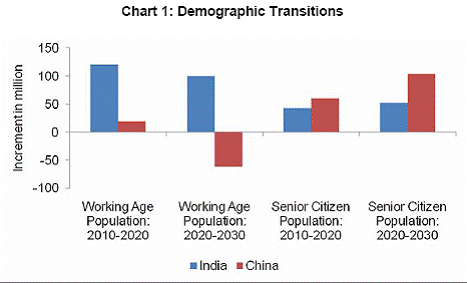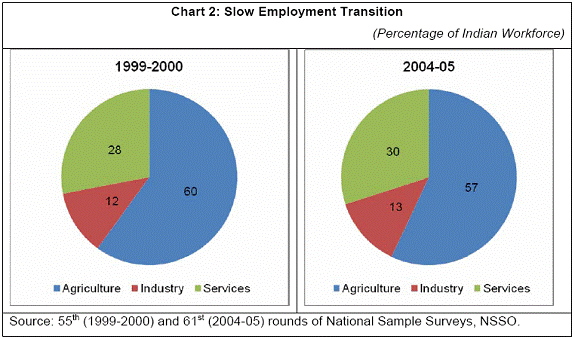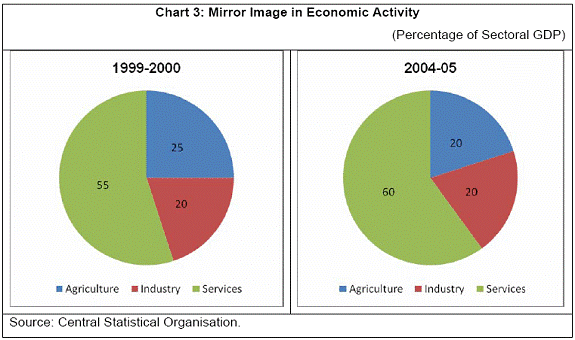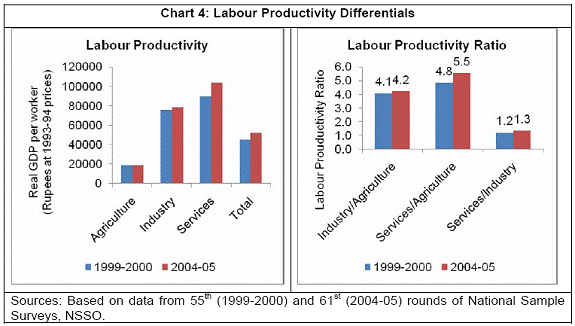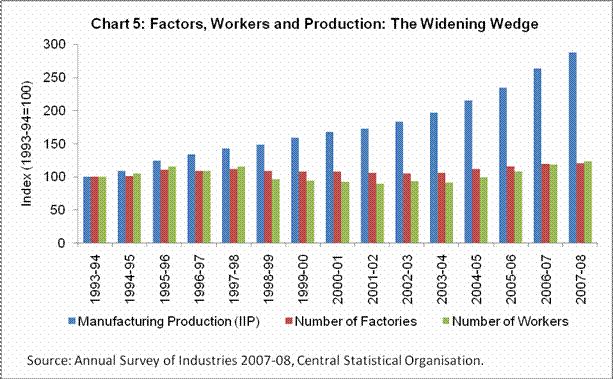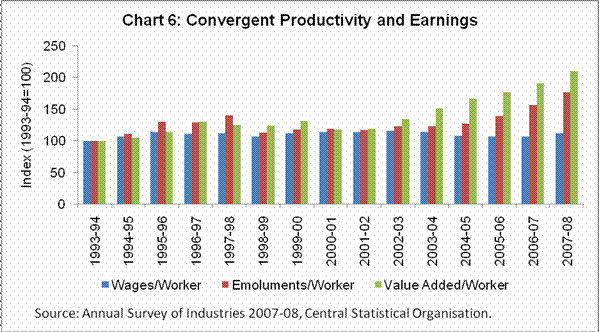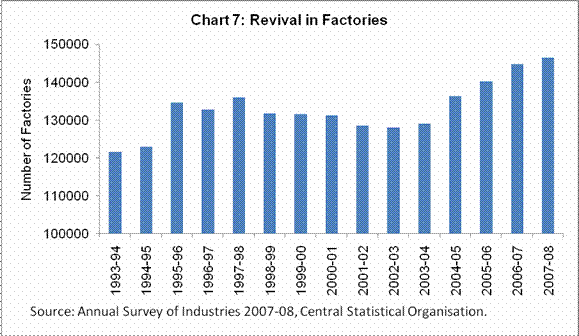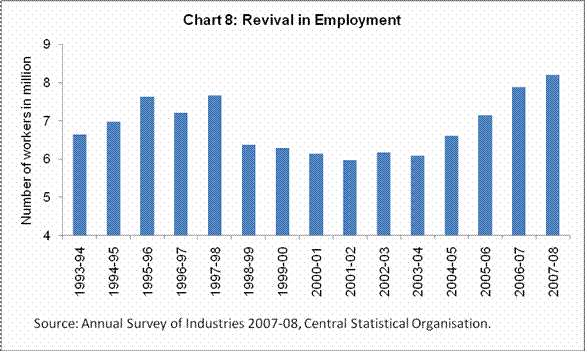 IST,
IST,


People, Jobs and Productivity: The 'Simple' Dynamics of Inclusive Growth
Dr. Subir Gokarn, Deputy Governor, Reserve Bank of India
delivered-on ഏപ്രി 01, 2010
Introduction Let me begin by thanking the Confederation of Indian Industry (CII) for inviting me to speak at its Annual Regional Meeting and National Conference on “Achieving Double-digit Growth”. The theme of the conference is, unquestionably, an issue of the utmost urgency for Indian policymakers. Although, in my current role, I am more focused on issues of macroeconomic stability and short-term growth and inflation prospects, today's theme is one on which I wrote and commented on frequently in my past positions and which I feel very passionate about. So, I am pleased that CII is giving me this opportunity to take a small diversion from my current concerns and re-visit some old, but equally important, ones. In what follows, I propose to view the issue of rapid and sustainable growth from three perspectives, based on a simple principle. The principle is that rapid, sustained and inclusive growth will take place when large numbers of people move from low-productivity jobs to high-productivity ones. Every single historical instance of this being achieved, cutting across time periods, regions, socio-political contexts and any other differentiator one might think of, validates this principle. As for the three perspectives, I will first briefly tread over the by now well-known ground of long-term demographic projections. This is necessary to highlight just how massive the scale of the challenge is. I will then go over some numbers on employment and productivity, with the purpose of demonstrating just how significant the impact of the right kind of employment transitions on inclusive growth can be. Finally, I will offer some suggestions on the elements of a strategy that will facilitate the required transitions. The People Imperative Let's look ahead over the next 20 years using the latest demographic projections made by the United Nations (Chart 1). Between 2010 and 2020, India will add about 120 million people in the working age segment, or 28 per cent of the global increase, while it will only add about 43 million people to the 60+ age group, or 16 per cent of the global increase. In sharp contrast, China will add about 19 million people in the working age segment 20-59, less than 5 per cent of the global increment. In the same period, it will add about 60 million people to the 60+ age group, about 27 per cent of the global increase.
Between 2020 and 2030, the differences between the two countries will be even starker. India will see its working age population increase by almost 100 million people, about one-third the global increase. Its 60+ population will also increase, but by a relatively modest 53 million people or 16 per cent of the global increase. On the other hand, China’s population in the working age segment will actually decline by a significant 62 million people. Its population in the 60+ segment will increase by about 104 million people, or 33 per cent of the global increment. I draw two implications from these numbers. First, independently of what will happen to China, the scale of the challenge for India is going to be unlike anything we've seen before. A growing backlog of young adults who can only find subsistence employment even while their aspirations and expectations rise, is hardly the formula for the kind of social and political stability that is an important pre-requisite for rapid and sustained growth. Thus, there is a potential vicious circle brewing here. The less effective the growth process is in creating jobs, both in terms of numbers and quality, the greater the political threat and, consequently, the less sustainable the growth process itself. Second, the contrast between Chinese and Indian demographic trends reflects an enormous opportunity for us to put our inclusive growth trajectory on track. These trends will drive Chinese wages steadily up, weakening the global competitiveness of their powerhouse manufacturing sector. Increasing levels of automation and robotization in Chinese factories is one potential solution but, from our perspective, the relative abundance of labour on our shores, appropriately skilled, trained and deployed, will provide global producers with a legitimate alternative to locate their production facilities in. India may have become the IT and ITES hub of the world over the past two decades; it now has the opportunity to become the factory to the world as well. Jobs and Productivity Let us now take a quick look at our record on achieving the desired jobs-productivity nexus. I will do this at two levels: first, at the aggregate level across the agriculture-industry-services spectrum; second in the context of the possibility of India becoming "factory to the world", at the level of the organized manufacturing sector, which will be key to realizing that aspiration. The story at the aggregate level is told by charts 2, 3 and 4. Chart 2 depicts a relatively slow transition in the labour force, using the household employment data from 55th (1999-00) and 61st (2004-05) rounds of the National Sample Survey as points of comparison. Over the five-year period, the labour force increased from 397 million to 456 million. 18 million of the increment was absorbed by agriculture, 13 million by industry and 28 million by services (including construction). The fact that two-thirds of the incremental number of workers were absorbed by sectors other than agriculture is a welcome sign from the productivity perspective, as I will demonstrate a little later on. However, the more worrying aspect of the slow transition is that the share of the total workforce employed in agriculture only declined from 60 per cent in 1999-00 to 57 per cent five years later. The share of industry increased from 12 per cent to 13 per cent and the share of services went up from 28 per cent to 30 per cent.
As is well known, this pattern is almost the mirror image of the distribution of GDP across the three sectors. Chart 3 displays the transition in these shares over the same period. Agriculture, already the smallest sector, lost some of its share, while services gained share in GDP somewhat more than they gained share in the labour force. In the overall context of my theme, the relative stagnation in the share of industry in both GDP and the labour force is of particular concern.
Let me now translate these two sets of numbers into broad productivity indices. Chart 4 displays the ratio of average GDP per worker, a rough indicator of labour productivity, in industry and services to that in agriculture. The ratio for industry rose marginally from 4.1 in 1999-00 to 4.2 in 2004-05. The ratio for services rose somewhat more, from 4.8 in 1999-00 to 5.5 in 2004-05. However, regardless of the magnitude of increase and the differential across the two sectors, the stark fact is that average labour productivity outside agriculture is about 5 times that in agriculture.
This has very significant implications for inclusive growth. Simple arithmetic says that every worker who moves from agriculture to other sectors will increase his/her net contribution to GDP by four units. Since earnings are typically correlated with individual productivity, this will necessarily translate into higher incomes for all the workers who make the transition. In short, the larger is the number of workers who move, the larger will be the increase in GDP as well as in the average earnings of the labour force. We have both faster and more inclusive growth. Obviously, this is an over-simplified model, but that should not detract from its value and usefulness in explaining the economic transformations of all the economies that have preceded us down this path. Introducing various levels of complexity will only provide more realistic estimates of the potential gains from the transition of workers; they will not undermine the basic logic of the argument. Let me now spend a little time taking a more focused look at the organized manufacturing sector, which, as I suggested earlier, will play a critical role in the economic transformation of India. The productivity comparisons at the aggregate level, while serving to make the point, significantly underestimate the true growth and inclusion potential of the transition out of agriculture and into industry and services. This is because the productivity numbers reflect the average GDP per worker across the organized and unorganized sectors. For a variety of well-known reasons, productivity in the former, in both industry and services, is an order of magnitude higher than in the latter. One obvious manifestation of this is the wage differential. Based on this, as well as other differentiating characteristics between the two sub-sectors, it would be reasonable to argue that organized sector employment is more desirable than that in the unorganized sector. But, the question is: where are the jobs? Chart 5 tells a story of essentially exclusive growth in the organized manufacturing sector. The slide combines data from the Index of Industrial Production and the Annual Survey of Industries, which covers organized (or “registered”) manufacturing establishments, on the aggregate number of factories and workers in the sector. Each variable is normalized to a value of 100 in 1993-94, so the time series in the slide reflect the relative changes in the three variables. It is strikingly clear from the pattern that, while real output from the organized manufacturing sector has increased substantially, by almost three times between 1993-94 and 2007-08, the number of factories and workers employed in the sector have barely grown at all. In fact, employment levels actually declined towards the middle of the period, before recovering somewhat in the later years. It appears that the Indian organized manufacturing sector has managed to triple its output from the same number of establishments, the average size of which has presumably increased and, most significantly, from virtually the same number of workers.
This, of course, means that the average productivity of those workers who had or were able to get jobs in organized manufacturing went up dramatically. Chart 6 displays this trend through the series “Value added/worker”. Significantly, total earnings per worker (emoluments/worker) behaved more or less commensurately with productivity. What is particularly important about the pattern on this slide, however, is the differential between “wages” – which reflect the fixed component of earnings – and “emoluments, which combines the fixed and variable components. The increasing proportion of the variable component in total earnings per worker indicates that the sector as a whole is beginning to build a welcome degree of flexibility into its employment contracts. I will return to this issue in the concluding section.
Finally, the rather worrying long-term impression of exclusion becomes somewhat less so if we look at more recent trends in the absolute numbers of both factories and workers. From Chart 7, it is apparent that organized manufacturing activity has experienced a revival in the number of factories during the recent growth boom. Even more reassuring is the picture in Chart 8, which suggests that this has been matched by a revival in employment levels. I believe that the increasing flexibility in wage contracts that was seen in Chart 6 has something to do with this revival. Wage flexibility allows both the downside and upside of the business cycle to be shared between the employee and the employer. To that extent, it makes hiring people more attractive, which is, after all, the ultimate goal.
The Components of a Strategy I have spoken about a simple principle and some simple arithmetic. I will now turn to the more complicated part of the problem, viz., how to translate the principle and the arithmetic into outcomes. Not that this is rocket science; as I said earlier, every country that has preceded us has achieved it. Here again, I risk treading over some well-known ground, but given both the magnitude of the challenge and the potential to become the factory to the world, I believe that this is a set of arguments that bears repeating. Three elements need to come together to achieve the transition in employment that is central to the achievement of rapid and inclusive growth. The first is the degree of flexibility in the employment contract. The evidence presented in the previous section suggests that setting up new manufacturing establishments and hiring more people was correlated with increasing flexibility in wage contracts. However, I do not think that wage flexibility by itself goes far enough. This needs to be extended to employment flexibility as well. The protection that individual workers receive from job security regulations, in my view, places a disproportionate share of the downside risk of a business cycle on the employer. In effect, the employer becomes the sole provider of a social safety net to the employee, which significantly raises the effective wage. It is no wonder then, that the organized manufacturing sector has experienced exclusive growth. The easing of job security regulations is, I believe, a critical requirement to both stimulating more rapid growth in this sector and making it more employment-intensive. We don’t need to look outside our country to find evidence of the strong connection between the flexibility of the employment contract and growth in employment. Our own services sector, which has provided the by far the larger employment opportunity, has the full benefit of employment flexibility. But, let me cite two instances from other countries that provide a politically palatable way to deal with the transition. The first is from China, which, in the early 1990s, did away with job security regulations for new workers and new establishments. This enabled the growth of manufacturing in the areas outside the Special Economic Zones, where a fully flexible labour market was in force anyway. Instead of people going to where the jobs were, jobs now began coming to where the people were. The second is from France, which, after some resistance, recently implemented its First Jobs Contract law. This allows employers to hire first-time workers below the age of 26 under different, more flexible, conditions than its existing workforce is employed under. This was motivated by the need to address widespread unemployment in this age segment, which in turn was attributed to the rather rigid labour regulations that deterred employers from hiring new workers. Apart from highlighting the role that flexibility in the employment contract plays in generating jobs, these instances also point to the importance of “grandfathering” of existing contracts in making regulatory reform politically acceptable. I believe that this is a lesson we must take seriously in forming our own strategy. The second is the matching of supply and demand for skills. Hundreds of millions of potential workers will add up to nothing if they are not adequately equipped to deal with the technological and organizational environment in modern manufacturing. Obviously, basic education, which provides literacy, numeracy, IT skills and, very importantly, teamwork capabilities, will play an important role. But, more specialized operating skills are far more difficult for the system to provide. From what I hear, the average shop-floor has moved far ahead of the capabilities of our vocational training system. I believe that industry has a significant role to play in this transition. The adoption of Industrial Training Institutes by industry associations is an absolutely welcome step, but considering the numbers involved, both the scale and the nature of the role will have to be thought through. The third is the provision of a safety net. While I think it is inefficient for the employer to bear the sole burden of providing a safety net, which is essentially what job security regulations do, I also think that a safety net is an absolutely critical requirement in an environment of employment flexibility. Experience from other countries indicates that reasonable safety nets can be built with contributions from employees, employers and the government. The development of a credible safety net, along with the grandfathering approach referred to above will, in my view, facilitate the transition towards a flexible employment regime in manufacturing. Conclusion We undoubtedly have a huge challenge in creating reasonable employment for hundreds of millions of people over the coming decades. I believe that we have a huge opportunity as well to become the factory to the world. Exploiting this opportunity by is critical to both accelerating growth and making it more inclusive.
Let me end by once again thanking CII for inviting to speak at this event and thank you all for listening to me. |
പേജ് അവസാനം അപ്ഡേറ്റ് ചെയ്തത്:






